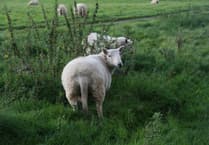A contemporary art space on the Powys/Herefordshire border has reopened with an exhibition of abstract paintings inspired by local landscapes of archaeological significance. Titled 'Palimpsest' the artwork by contemporary artist Wayne Summers is the first to be exhibited at RidgeBank in Kington since the gallery had to suddenly close its doors in January 2023 due to a dry rot infestation.
Director and curator Caroline Allen said: “It was awful having to close within only a year of launching. However, the remedial works meant we had to clear out two underground bank vaults which we decided to convert into natural dark exhibition spaces which are ideal for light sensitive works. Wayne has taken advantage of this by creating a new neon installation especially for one of the chambers.” Wayne, who lives near Kington, has 21 exhibits on display in oils, acryllics and neon which can be seen from 12 midday to 5pm (Wednesday to Saturday) until June 30. In keeping with RidgeBank’s aim to reflect the rural, Wayne’s work draws upon the local landscape, specifically sites of ancient archaeological significance, which he has used for inspiration. Wayne is a painter who lives locally and is currently studying for his Fine Art PhD at Aberystwyth University, where he also gained his MA in Fine Art (Painting) in 2019. He has exhibited UK and Europe-wide in numerous group and solo shows. Wayne said: “I am really grateful to Caroline for making this space available for Kingtonians and myself. It has given me the opportunity to try out my ideas in public for my PhD before I show it publicly for the second time.
“More importantly it is a chance to show contemporary works to a rural audience. Most people in this town would not have the opportunity to go and see something in a London gallery and that is a really important thing to do.” The title of the show represents the layering of time, place and peoples. Examining traces of prehistoric monuments including the nearby ritual landscape at Hindwell, the works in this show are an attempt to decipher the significance of these sites by speculating upon the festivals, events and rituals which may have taken place there.
Without recording specific topographies, the work seeks to engage the viewer in a contemplation of a vanished and inexplicable past to reassert the value of mystery in a world largely predicated on the empirical.
Each of the works behaves as a psychogeographical find, offering clues into the lives and landscapes of our distant ancestors; the works often incorporate ancient symbols, such as solar circles, which echo and reference the circularity of many monuments. Collectively they become a hoard of allegorical remnants, inviting us to wonder upon the magic and mysteries of the past and to perhaps help alleviate the harsh realities of the present.





Comments
This article has no comments yet. Be the first to leave a comment.